
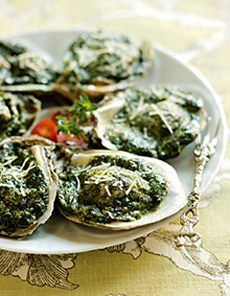 Oysters Rockefeller are fancy bivalves indeed. The original recipe, created at Antoine’s in New Orleans, did not contain spinach but parsley, puréed and strained celery, chives, olive oil, and capers. Photo courtesy of MackenzieLtd.com. Oysters Rockefeller are fancy bivalves indeed. The original recipe, created at Antoine’s in New Orleans, did not contain spinach but parsley, puréed and strained celery, chives, olive oil, and capers. Photo courtesy of MackenzieLtd.com.
|
|
| This glossary was compiled by THE NIBBLE EDITORS. It is updated regularly. William Lance Hunt, a freelance writer in New York City, contributed to the first version. |
|
October 2005
Last Updated June 2019
|
 |
Fish & Seafood Glossary
Page 2: Seafood Types Beginning With B
This is Page 2 of a 13-page glossary featuring different types of fish and seafood. Here, seafood types beginning with B, such as barracuda, bass, bluepoint oyster and butter clam. Click on the links below to visit other pages. See our 60+ other food glossaries, each featuring a different favorite food.
Click on a letter to get to another section of the glossary.
a b c d e f g h i j k l m n o p q r s t u v w x y z
This glossary is protected by copyright and cannot be reproduced in whole or part.
BARRACUDA
|
Usually a game fish, the barracuda can occasionally be found in American markets under the name the Pacific barracuda or California barracuda. It usually ranges from 5 to 10 pounds and has firm-textured, moderately fat meat, which is good grilled or smoked. Mahi mahi and wahoo and are good substitutions. The great barracuda, which can grow to larger than 100 pounds, is usually not eaten, as its flesh is often toxic.
|

Photo courtesy of NCFisheries.net. |
BARNACLE
|
A crustacean that forms calcareous (containing calcium or limestone) shells. Barnacles attach themselves to submerged surfaces—both natural, such as rocks, whales and large fish, and man-made, such as ships, wharves and pilings. The two most important barnacles for for eating are the acorn barnacle and gooseneck barnacle, also known as the stalked or goose barnacle. This variety is particularly popular in Spanish, Portuguese and Moroccan coastal cuisines, where they are quite plentiful. An uncommon item in the U.S., the barnacle can be found in some specialty and online fish markets. It tends to be gritty and needs a thorough rinsing prior to a quick boiling or steaming, like mussels.
|

While many people think of barnacles only as the parasitic attachments to boat hulls and other human-made structures, they actually are seafood, distantly related to lobsters and crabs. Photo courtesy of Wikipedia.
|
The flavor profile is similar to other crustaceans (crab, lobster or shrimp, e.g.). A barnacle is eaten by peeling off the outer skin and biting off the neck. Watch for a spurt of orange liquid when peeling!
BASS
|
A general term used for many, sometimes unrelated, freshwater and saltwater fish, many with spiny fins. True bass varieties available in the U.S. include the grouper (a class of sea bass), sea bass and striped bass. Many of the freshwater fish usually referred to as bass are not actually bass but sunfish. These include the largemouth, redeye, rock, smallmouth and spotted bass.
|
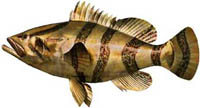
Grouper. Photo courtesy of LyndenHuggins.com. |
BIVALVE
|
Any mollusk that has two shells hinged together by a strong muscle, such as a clam, oyster, cockle or mussel. The mollusk is important around the world, in many diverse cuisines. Some varieties can be eaten raw, but most are too tough and must be cooked.
|
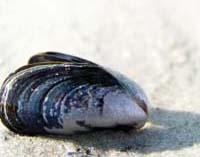
Photo of clam courtesy of Sxc. |
BLACK COD or ALASKAN BLACK COD
|
Black cod is also known as sablefish and butterfish. It is considered one of the finer fish in terms of flavor and texture. Alaskan black cod has a silky, rich texture and ultra-high omega-3 oil content, which makes the pale pink flesh fairly oily. When cooked, the flesh becomes white and yields large flakes. The flavor is likened by some to salmon. They range from 4 to 7 pounds whole, and are caught in the Pacific Northwest and Alaska. Also see butterfish.
|
|
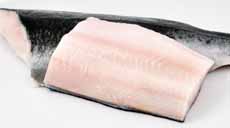

|
| Photos courtesy FoodShed Exchange. |
BLACKFISH or BLACK PORGY or BLACK TROUT or CHOWDERFISH or OYSTERFISH or TAUTOG
|
Popular in Chinese cuisines, and important in the south of New England, this is a lean, meaty fish. While it has excellent flavor, it also has a network of tiny, fine bones embedded in the meat. This fish goes by many names: in addition to all of the names above, it’s also called Chinese Steelhead and Black Ruff. It can be found in the market as whole fish, fillets, steaks, and does very well cooking, as the meat does not flake or fall apart easily. The skin is not edible.
|
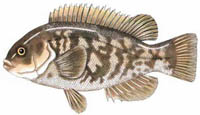
Photo courtesy of Maine Department
of Marine Resources.
|
BLACK SEA BASS or SEA BASS or BLACK WILL or CHUB
|
A true bass, the black sea bass can be found all along the Atlantic coast of the U.S., though it’s more abundant from New York to North Carolina. A very popular fish, it has firm, moderately fat flesh with a delicate flavor. Black sea bass can be found whole, as well as in steaks and fillets. Because it is firm-fleshed, it can be cooked by almost any method.
|
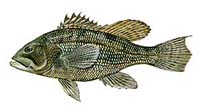
Black sea bass. Illustration courtesy of NCFisheries.net. |
BLENNY
|
An odd fish, it is covered not in scales but with a mucous membrane. The blenny is small (only 4 to 6 inches in length) and found in both fresh water and salt water. It has mild, white, flavorful flesh, suitable for frying. There are recipes for blenny dating from Medieval times. Today, it is unusual to find in markets.
|
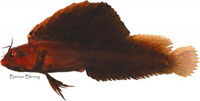
Photo courtesy of
OceanExplorer.noaa.gov. |
BLUEFISH
|
An Atlantic Ocean and Gulf Coast fish, the bluefish ranges from 3 to 10 pounds and has a fatty, dark, fine-textured flesh that tends to be a bit fishy, even if the darker, oily strip that runs down its center is removed (some people savor that part, however). Bluefish is best when baked or broiled and served very plainly, or with assertive condiments or sides.
|

Illustration courtesy National Museum of Natural History, Smithsonian Institution. |
BLUEPOINT OYSTER
|
Though originally the regional name for an Atlantic oyster found in the Blue Point, Long Island area, “bluepoint oyster” is swiftly becoming a generic term for any of one of the many small- to medium-sized Atlantic oysters measuring roughly two to four inches long. They are typically eaten—and considered the best oyster for eating—on the half shell. They can also be served as Oysters Rockefeller (broiled with herbed and seasoned bread crumbs), among other preparations.
|
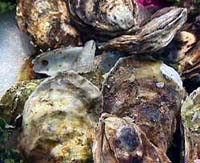 |
| Photo courtesy of PhilsFishMarket.com. |
See our Oyster Glossary for more detailed information about the bluepoint oyster and other varieties.
BOTTOM FEEDER
A scavenger fish that feeds low on the food chain. The catfish is a scavenger.
BOTTOM DWELLER
A fish species that lives and feeds on the bottom of a body of water (lake, ocean, river).
BOTTOMFISH or BOTTOM FISH
Fish species that live on the bottom of the ocean. Cod, flounder and haddock are examples of bottomfish.
BREAM
|
More of a catch-all term for any of several freshwater or saltwater fish than a fish species, per se. It’s most close to an alternate term for any fish of the sunfish family, a major North American freshwater fish. But bream is also loosely used to refer to saltwater fish such as the American porgy, the Japanese sea bream and the French daurade, which are all quite different.
|

Golden threadfin bream. Photo
courtesy of afcd.gov.hk. |
BRILL
|
Difficult to find in the U.S., this is an excellent European saltwater flatfish closely related to the turbot, for which it is often mistaken. Like most flatfish, the brill has a flakey, light flesh that is best broiled, fried, baked, grilled or poached.
|

Photo courtesy of ChartingNature.com. |
BUFFALO FISH
|
This is a common name for one of the Sucker family, a fish related to the catfish. It is a freshwater fish, found mainly in the central states of the U.S. Its lean flesh is coarse, but sweet, and has a network of small bones throughout. It can be baked, poached, sautéed or grilled. Buffalo fish can be found whole, in fillets or steaks in some markets. It can also occasionally be found smoked.
|
BURBOT
|
This freshwater cod is a sport fish, but not often sought because of its coarse meat. Burbot is also called eelpout, freshwater cod, ling, lota iota, loche, maria, methy, lush or lawyer, and has moderately lean, white flesh with good flavor. It is usually poached, sautéed, broiled or baked. The burbot is rarely found in markets.
|
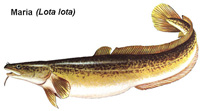
Photo courtesy of Canada Department of Oceans and Fisheries. |
BUTTER CLAM
|
The butter clam is a small, hard-shell clam native to the protected bays and estuaries of the Pacific Northwest. Canada is its largest producer, with Washington State’s Puget Sound the second-largest source. Most butter clams are caught wild; a quarter are farmed. This sweet clam can be cooked in a variety of ways, including steaming, stewing and frying. See also Clam.
|
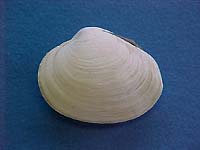
Photo courtesy Edmonds Discovery Programs. |
BUTTERFISH or SABLEFISH or BLACK COD
|
Exceptionally rich and flavorful, the small (average 8 ounces), high-fat butterfish has sweet, tender meat and rich flavor. Sablefish is the most expensive bottomfish landed by U.S. fishermen. Although more than 90% of the sablefish catch is exported to Japan, a growing number of chefs in the U.S. are learning to appreciate its unique, buttery taste and texture.
|

Photo courtesy of PacSeafood.com. |
Although it is also called black cod, the sablefish does not belong to the cod family. It belongs to the Anoplopomatidae family, a unique group of fish. It has numerous other names as well: Depending on the region, the butterfish/sablefish/black cod is also known as dollarfish, harvestfish, Pacific pompano, pomfret, pumpkin-seed, shiner and starfish. Usually sold whole, it makes for a great pan preparation. Occasionally, it is found smoked.
Continue To Page 3: Seafood Terms Beginning With C
Go To The Alphabet Index Above
Lifestyle Direct, Inc. All rights reserved. Images are the copyright of their respective owners.

|




















